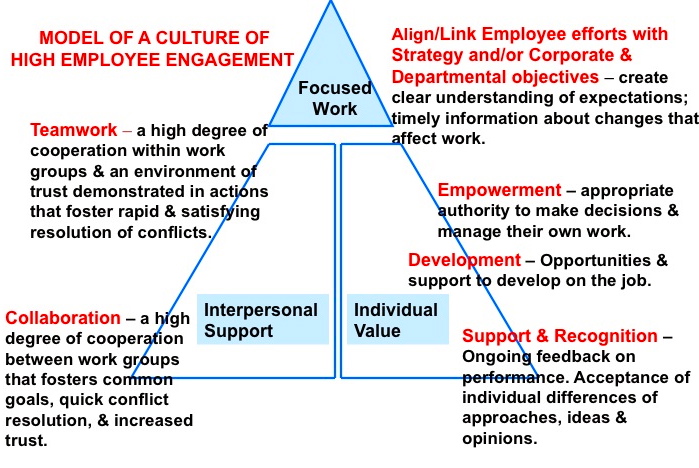MANAGEMENT PRACTICES and ENGAGEMENT
- August 4th, 2021
- Posted in Management Practices
- Write comment
MANAGEMENT PRACTICES
CAN KILL ENGAGEMENT
TRUST is basic component of cultures where employee engagement exists at a high level. More on Trust next time.
The following practices, which are essentially management deficiencies, are the other factors that are noted as playing a significant role in the level of employee engagement. In companies or departments within company where engagement is low you will find some or all of these deficiencies.
A POOR SELECTION PROCESS
Placing the wrong people in the wrong jobs; It takes more than direct experience and the right degree to be the right person for a job. It takes enthusiasm and interest in the work. Train interviewers to identify interest and enthusiasm. If interest and enthusiasm are there, even the most reserved candidate will display these for the job you are attempting to fill as you describe it to them or when they describe their past accomplishments in a similar position.
POORLY PLANNED TRAINING
As to both content and time frame for completion, and the lack of an on-boarding program will leave employees feeling frustrated and unattached to the job and the company. (On-boarding is not orientation)
NARROWLY STRUCTURED JOBS
With little opportunity for learning and growth a motivated employee is transformed into a bored employee.
EMPLOYEES WHO DO NOT UNDERSTAND THE CONNECTION BETWEEN THEIR EFFORTS AND THE COMPANY & DEPARTMENT’S OBJECTIVES
They feel their jobs are meaningless. A better model for Performance Management is needed: One that illustrates alignment of employee efforts with departmental and organizational goals.
EMPLOYEES WHO ARE CAPABLE, EXPERIENCED AND EDUCATED ARE NOT GIVEN THE APPROPRIATE AUTHORITY AND AUTONOMY TO DO THEIR JOBS.
Often it will be high turnover rates that start to attract attention followed by work quality issues and absenteeism. However, in the economic conditions of the last few years, people have remained in their jobs out of the lack of options, so management deficiencies may go un-noticed while dis-engaged employees negatively impact productivity. Once the labor market improves, low engagement can become high turnover with the additional problem of difficulty in finding the replacement talent you need.
I strongly recommend Employee Perception Surveys done every other year to learn about how well you are doing in promoting employee engagement.
An Employment Perception Survey is like taking a temperature. Low scores will tell you something is wrong, but you will need to dig deeper to pinpoint the extent of issues and potential solutions.
Also, remember, “perception is reality,” your survey responses will lead you to correct real issue and correct erroneous perceptions – both are a problem.
These are some of the areas where an EPS would provide information about the efficacy of management practices and whether or not they promote employee engagement.
- Perception of jobs and the work
- Work environment
- Attitudes toward quality and quality efforts
- Commitment to the customer and customer relationships
- Management support
- Career advancement/opportunities
- Opportunities for training and development
- Ability to improve work/Feedback
- Overall understanding of the organization’s goals/priorities

 Follow
Follow
No comments yet.